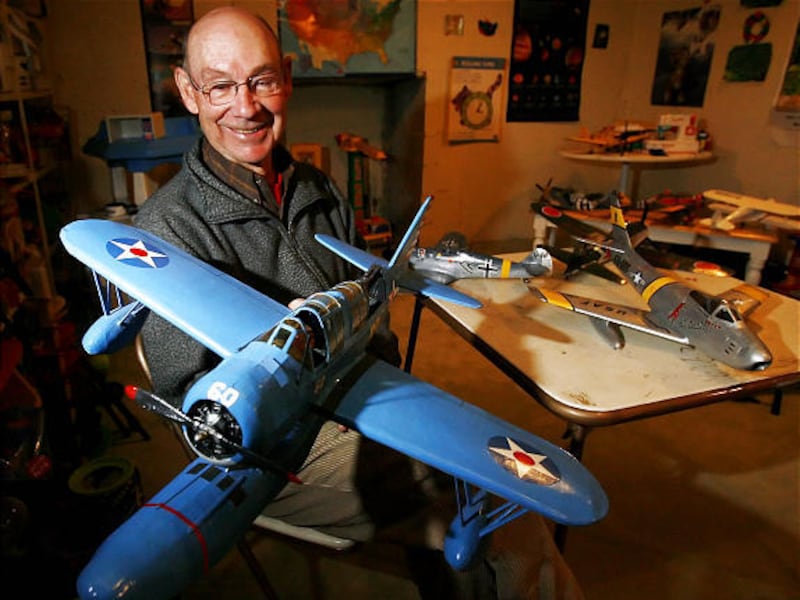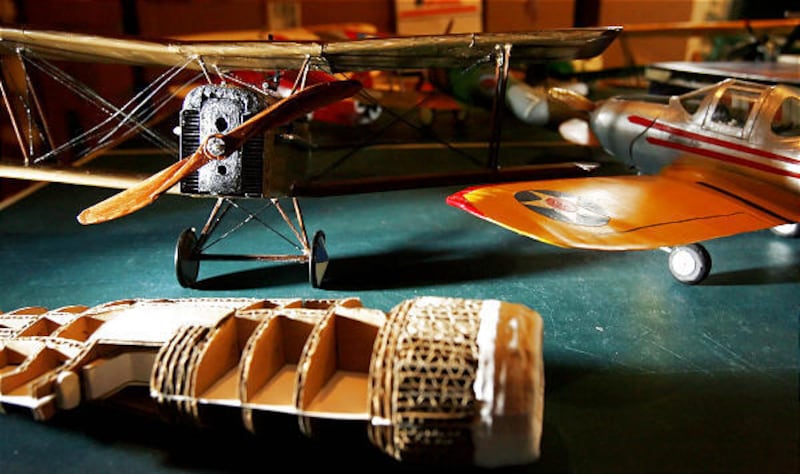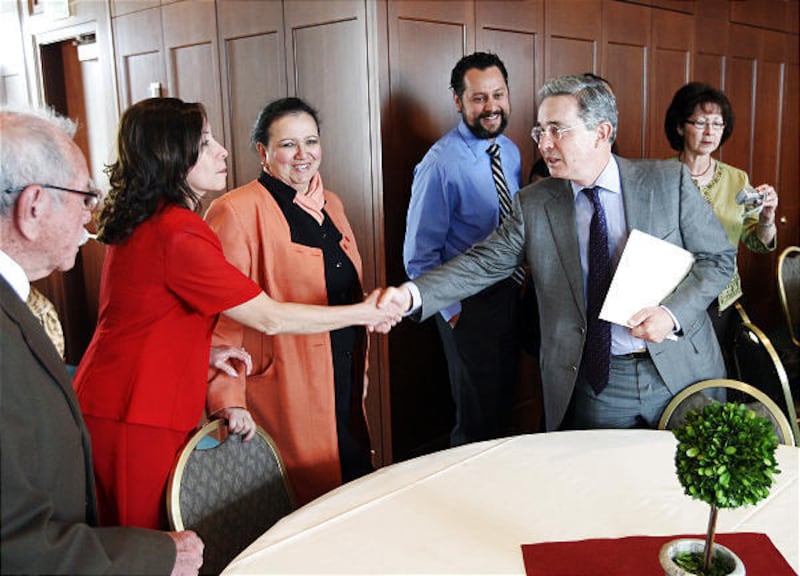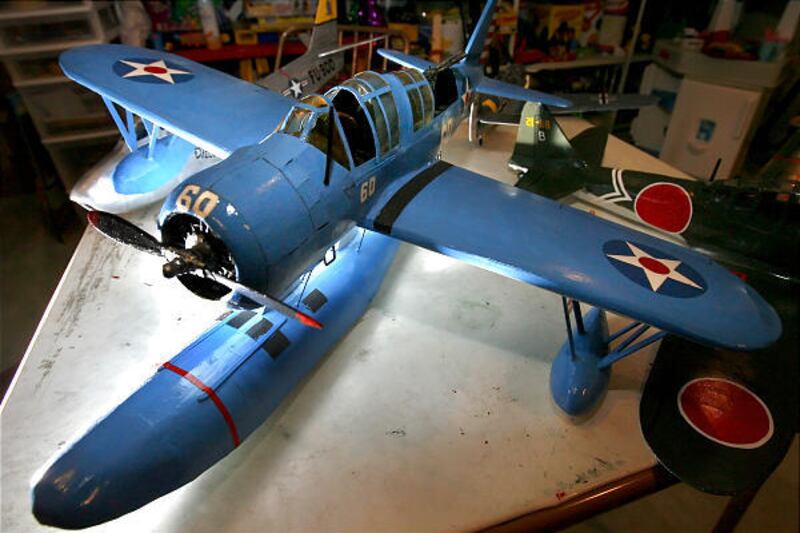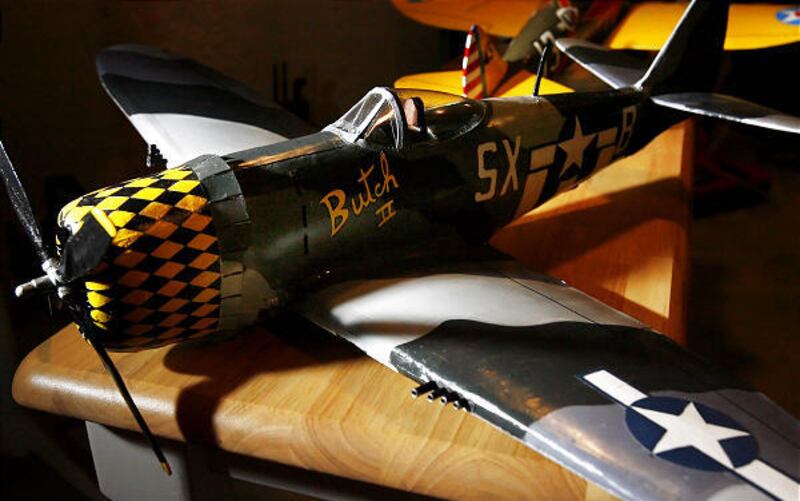WEST JORDAN — Glen Smith takes the making of paper airplanes to new heights.
Using only simple materials such as paper, cardboard, glue and paint, Smith creates models of airplanes that capture not only detail of design but also a fascination with flying.
Smith has been into airplanes "ever since I can remember. I started out with those stick models that were powered by an elastic. As a kid I put together some of those models that came in kits."
But there were too many little parts and pieces to really make the kits fun, he said. "I always wanted to make something that would be just my own."
It would take him a while to get to that point. But he never lost interest in airplanes.
In the Army, he became an airplane mechanic. "This was just after the Korean War had ended and before the Vietnam War started. I wanted to be a helicopter pilot, and I qualified to attend the school. But then it closed down. They told me I could hang around for a year as a mechanic, and maybe something would open up."
But Smith had just married and decided to use his educational benefits under the G.I. Bill and attend the Spartan School of Aeronautics in Tulsa, Okla., to learn more about mechanics.
After graduating, he hired on as a mechanic with Hughes' Air West. "That was taken over by Republic. And then Republic was taken over by Northwest." Smith still had a job, but it was in Minnesota. "At that time my oldest daughter had asthma, and doctors thought the Minnesota climate wouldn't be good for her. So, we decided that the family would stay here in Utah, and I would commute to Minnesota."
That started back in 1997, and it worked pretty well, he says. The company allowed him to take his vacation one day at a time, so he often was able to spend three-day weekends in Utah. "I had a little one-room apartment in Minnesota for the time I spent there."
And that's where Smith began making his model planes.
"It was lonely there, and I needed something to do. But I didn't know quite how to do it. I wanted something simple that wouldn't cost too much. But I didn't think I could make anything halfway decent out of paper."
One of the other men in the electric shop was "a 'starving artist,' I guess you could call him. He worked to pay the bills, but he really liked to paint. I told him it was neat to have a hobby like that, and he asked me what I would like to do. I told him that I'd like to build model airplanes, but I didn't know how. He told me, 'Just work at it.' He kept asking me if I had started, so after a few weeks, I decided to try it."
After some trial and error, Smith said he came up with a way to create his planes. "I would find pictures in a book and project them onto the wall and trace the outline. I needed a front and a side and a top view."
He would trace the outline onto poster paper and cut it out and then use bits of cardboard to fill out the shape and to give it strength. "Then I'd cover that with poster paper and use newspaper to fill in the seams." The canopies and windows are cut from a clear plastic pop bottle. His propellers are made from tongue depressors.
He paints the plane with water-based acrylic paints. He cuts out letters and insignia for the decals and glues those on and covers the entire plane with a clear coat.
"Every plane is 100 percent my doing," he says. "I don't use any kits or anything other than my simple materials." Some of the planes have retractable wheels and tanks that can slide on and off, he says. All the propellers spin.
"I try for a little realistic detail, but I go for the overall appearance of the plane. Some models take it right down to the rivets, but I just go for the look. To me it is art. It is there to look at, not to play with, not to fly."
He figures that each plane costs $10 or less in materials — "some I just use the scraps, so they don't cost anything." But they each take about 80 hours of his time to complete. "They were a great way to kill time and take away the loneliness in Minnesota," he says. "I find that when you're doing something you're interested in, time zips by. I would love sitting at my card table, listening to the radio and working on my planes."
In Minnesota, he took some of his planes into the shop, and the guys there loved them, he says. "So we started hanging some of them up in the hangar. Pretty soon word spread, and people were coming from all over the field to see them. On career days, when the kids came in, they were more interested in the planes than in what their dads did for work. I think kids relate well to models."
The planes were a good conversation piece, he says. "Guys would come in and talk about their careers and the planes they've known. We had some nice chat sessions. We all had airplanes in common."
Every one of his models has a story. He once took his daughter to March Air Reserve Base in California, because she was interested in planes. He later made her a model of a plane they saw there. "She could look at it and remember that day. We had so much fun."
He built a model of a barn-storming plane for his mother, who was 87 at the time, to remind her of the day when she was a young girl living in Duchesne. A barnstormer came to town and she and a girlfriend went up in the plane.
He had built models of World War II planes, of both U.S. and Nazi origin. He's built Japanese and Russian planes. He's built planes that were flown in early air races and that were flown by early test pilots. "Some of the guys would come into the hangar and say, 'Why don't you have such-and-such; that's my favorite plane.' So I would make one of those."
He built one for a co-worker who went into the hospital with cancer. "We didn't know if he was coming back. But when he did, and he saw that plane hanging here, that was a special day."
Smith's own favorite is probably the Folkwolf 190, he says. It was fun to make, and had an interesting war-related history.
In all, he's built nearly 100 of his models. He's also given a lot of them away.
When he retired from Northwest in 2005, "I gave away about 30 planes to the guys in the shop. I gave them their favorites." Then he packed up the rest in a rented car, and for the most part, they've remained in storage in his basement.
"I really don't know quite what to do with them," he says. "Some people think I should sell them, but I wouldn't know what to charge. Some people think a museum might be interested, but I don't know."
Since moving back to Utah full time, he hasn't had as much time to build new ones. "Right now, I'm working part time, and we have two of our grandchildren living with us during the week to go to school here, so I just don't have the time. But I figure when I retire for good, I'll get back to it more. It'll be a good way to keep out of my wife's hair for part of the day."
Meanwhile, he occasionally gets some of his models out. "It's like unwrapping old friends," he says. Making them has brought him a lot of joy. "To think that you can create something that you have in your mind, that you can take that idea and make it real — it's amazing what you can do with just paper and glue. But that's part of the challenge, to do something different."
Smith can look at his creation, and say, "That's my airplane. I did the drawing. I did the artwork. I did the painting. And no one can say I'm spending too much money. There's a certain amount of satisfaction in that. It's just been a lot of fun."
E-mail: carma@desnews.com

